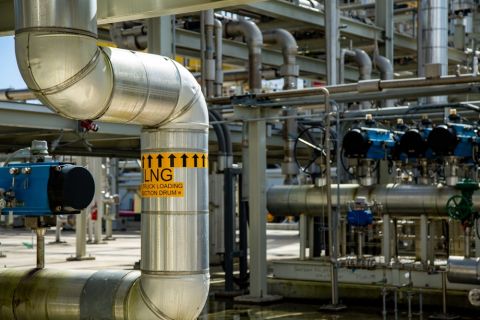Two major E&P midyear surveys show that companies worldwide are planning to spend 5% more in 2003 than in 2002, up from the approximately 4% increase they expected at year-end 2002. A recent Lehman Brothers re-survey was of 330 oil and gas companies who plan an average 5.4% increase in their worldwide E&P spending in 2003, for a total of $138.8 billion. In the year-end 2002 survey, 323 companies projected an average 4.2% spending increase. A recent Smith Barney re-survey was of 234 companies, who indicated a 2003 spending increase of 5.9%, well above December 2002 projections (by 226 companies) of 3.8% more spending than in 2002. U.S. spending is higher this year than the surveyed companies expected at year-end 2002: Lehman reports that 247 companies with U.S. spending plans project that spending to rise an average 2%. At year-end 2002, they had expected their spending to decline an average 0.7%. "Given the rise in the U.S. rig count year to date (197 rigs, or 23%), we had expected spending to be greater than the survey results indicate," Lehman reports. "We believe that this is a result of overspending of 2002 budgets (by $1.4 billion, or 5%) and given that the rise in the U.S. rig count has been limited primarily to the land-rig count (203 rigs year to date, or 28%), which tends to be driven by the smaller oil and gas companies." Among independents in general, 2003 U.S. spending is expected to grow 4.6%, versus the expected 0.4% decline that was drop forecast in December. Spending by smaller independents-those with E&P budgets of less than $50 million-is expected to rise 31.7%. "Smaller independents typically respond quicker to industry trends," Lehman reports. "We anticipate that certain larger independents and majors may follow suit and may simply just overspend their existing 2003 budgets, like they did in 2002, or raise budgets after midyear." The recent Smith Barney survey forecasts U.S. spending growth of 1.1%, up from the 0.1% increase that was forecast in December. "In our view, this result raises doubts as to whether the most optimistic [financial] expectations for U.S. oil-service demand are realistic," Smith Barney reports. U.S. gas-price sensitivity has fallen significantly, the investment-banking firm notes. In December, the average U.S. gas price assumption was $3.55 per thousand cubic feet (Mcf), and $4.20 was cited as the upside threshold that would trigger a 10% spending increase in 2003. But in the recent survey, the average gas-price assumption leaped to a record $4.55, with $6.11 cited as the new upside threshold. "Due to these results, we believe that U.S. oilfield-service demand may have difficulty meeting aggressive expectations unless spending-in other words, gas-price sensitivity-picks up significantly in the second half," Smith Barney reports. Canadian spending In Canada, Lehman Brothers forecasts 2003 spending to grow12.8%, compared with the 7.2% gain estimated in December. Canadian 2002 budgets were underspent by about 1%, and 2003 budgets were increased about 4%. Smith Barney projects 2003 spending growth in Canada of 13.5%, compared with the 5.7% increase forecast in December. The growth is attributed to higher gas prices, a milder spring break-up and the completion of several major mergers and acquisitions. Outside North America Lehman Brothers' recent survey shows 104 companies with spending plans outside North America expect their 2003 spending would be up an average 5.7%, roughly the same as what was projected in December. Smith Barney surveyed 87 companies with non-North American capex plans. They estimate spending growth of 6.6%, up from 4.9% in December. "Of note, 60% of the entire 6.6% of projected incremental growth emanates from Pemex, the Mexican national oil company," Smith Barney reports. In conjunction with its spending survey, Smith Barney raised its 2003 worldwide rig-count forecast to 2,130 from 2,088-representing 16% year-over-year growth. "We believe rig-count growth will outpace spending growth, as suggested by the survey results, because pricing has declined from a year ago and the mix has shifted toward land and away from offshore," the firm reports. "Offshore projects are more service intensive than land projects, by a significant factor, and thus more expensive than land-based programs." -Jodi Wetuski
Recommended Reading
Battalion in Compliance with NYSE American after 2023 Meeting
2024-02-13 - Previously, Battalion Oil was not in compliance with the NYSE after failing to hold an annual meeting of stockholders during the fiscal year ending Dec. 31.
JMR Services, A-Plus P&A to Merge Companies
2024-03-05 - The combined organization will operate under JMR Services and aims to become the largest pure-play plug and abandonment company in the nation.
New Fortress Energy Sells Two Power Plants to Puerto Rico
2024-03-18 - New Fortress Energy sold two power plants to the Puerto Rico Electric Power Authority to provide cleaner and lower cost energy to the island.
Tellurian Executive Chairman ‘Encouraged’ by Progress
2024-03-18 - Tellurian announced new personnel assignments as the company continues to recover from a turbulent 2023.
Kissler: OPEC+ Likely to Buoy Crude Prices—At Least Somewhat
2024-03-18 - By keeping its voluntary production cuts, OPEC+ is sending a clear signal that oil prices need to be sustainable for both producers and consumers.





